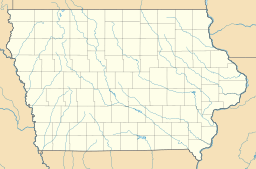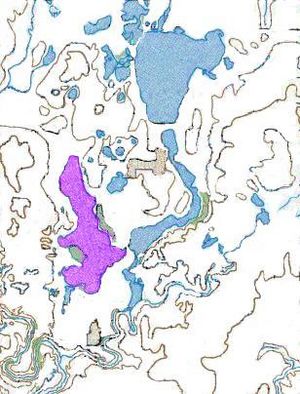West Okoboji Lake facts for kids
Quick facts for kids West Lake Okoboji |
|
|---|---|
 |
|
| Location | Dickinson County, Iowa |
| Coordinates | 43°23′04″N 095°09′34″W / 43.38444°N 95.15944°W |
| Catchment area | 125 sq mi (320 km2) |
| Basin countries | United States |
| Surface area | 3,847 acres (1,557 ha) |
| Average depth | 39 ft (12 m) |
| Max. depth | 136 ft (41 m) |
| Surface elevation | 1,398 ft (426 m) |
| Islands | 0 |
| Settlements | Arnolds Park Okoboji Wahpeton West Okoboji |
West Okoboji Lake, also called West Lake Okoboji, is a natural lake in Dickinson County, Iowa. It is located in northwest Iowa, United States. This lake is part of a group of lakes known as the Iowa Great Lakes.
For a long time, the Santee or Dakota Sioux people lived in this area. In their Dakota language, they called the lake Minnetonka. This name means "great waters."
Several towns are located along the lake's shore. These include Arnolds Park, Okoboji, West Okoboji, and Wahpeton. The name Okoboji comes from the Dakota name for the lake. Wahpeton was the name of an important Sioux group in the 1800s. Today, the Sisseton-Wahpeton Sioux are a recognized tribe.
Exploring West Okoboji Lake's Geography
West Okoboji Lake is the deepest lake in Iowa. Its deepest point is 136 feet (41 m). It is also the second largest lake in Iowa, after Spirit Lake. The average depth of the lake is 39 feet (12 m). The area of land that drains water into the lake is about 125 square miles (320 km2).
Fun Activities at West Okoboji Lake
Because the lake is so deep, it's a very popular spot for many water activities. People enjoy motor boating, water skiing, sailing, and swimming here.
The lake is also a great place for fishing. Some of the most common fish caught are yellow perch, bluegill, and walleye. You can also find smallmouth bass, northern pike, muskie, crappie, and white bass.
Is West Okoboji Lake Really "Blue Water"?
For almost 100 years, a story has been told that West Okoboji is one of only three "blue water" lakes in the world. The other two lakes often mentioned are Lake Geneva and Lake Louise. However, this story is not true.
Scientists say there is no real scientific basis for this idea. It probably started with people who wanted to promote the area a long time ago. Dr. John Schalles, a scientist who studies lakes, has heard this myth often. He says people sometimes claim National Geographic published this, but there is no record of it.
Another scientist, Dr. Roger Bachman, agrees. He explains that "blue water lake" is not a scientific term. However, lakes with very pure water, like Lake Tahoe or Crater Lake, do look blue. This happens because when sunlight enters the water, other colors are absorbed more than blue. This leaves more blue light to reflect back, making the water look blue.
Dr. Schalles has a theory about how the myth started. Early scientists studied many lakes, including West Okoboji. They often compared their findings from West Okoboji to Lake Geneva in Wisconsin. Perhaps people heard about these comparisons and thought it meant the lakes were special in the same way. They might have thought it was a good way to attract visitors.
Even though West Okoboji isn't one of only three "blue water" lakes, scientists agree it has excellent water quality. For a lake in its region, its water is very clear and has a good color. The Iowa Department of Natural Resources has even given West Okoboji a special title: an "Outstanding Iowa Water."




